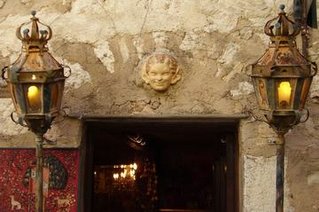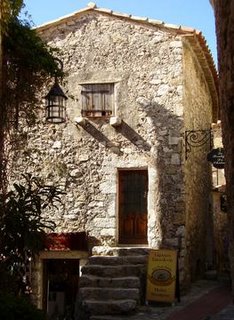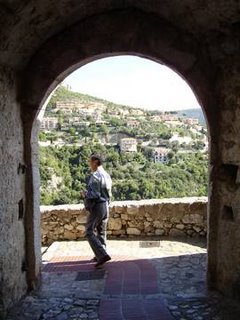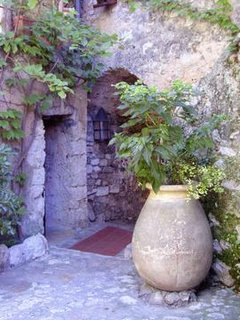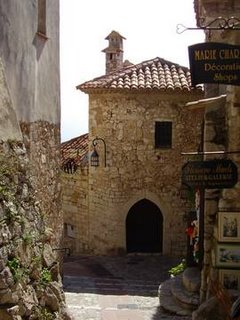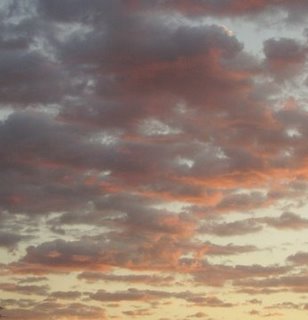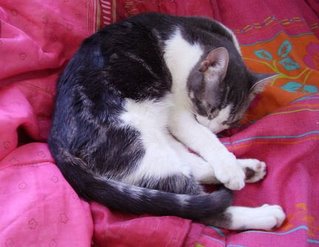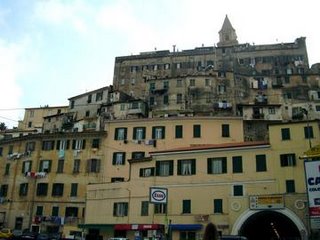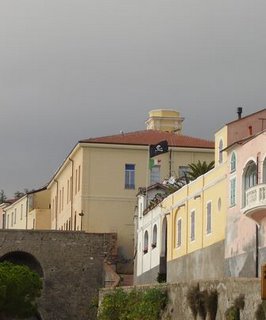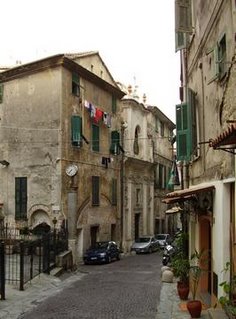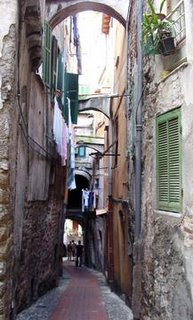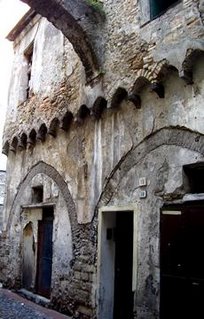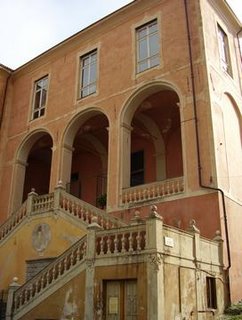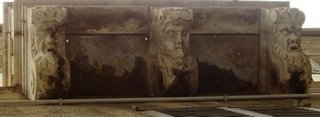When he stayed in Eze, he lived in Eze Bord de Mer rather than in the perched mediaeval village. However, he would apparently walk up the steep mule path to the mediaeval village every day - which is a considerable hike.
Nietzsche wrote in Thus Spake Zarathustra [which he wrote partly in Nice and Eze ], "I draw circles around me and sacred boundaries; fewer and fewer men climb with me on ever higher mountains,—I am building a mountain range out of ever more sacred mountains."
Its easy to see how the path ascending 400metres [1300 feet] through an apparent abyss topped by weirdly shaped mountains could have inspired his writing.
This is a photo of the zig-zagging path as it winds its way up to the village of Eze-the lighter coloured zig-zag is the mule path.
 The estimated time for walking up the path according to the tourist information is an hour and a half and the descent is estimated at 45 minutes.
The estimated time for walking up the path according to the tourist information is an hour and a half and the descent is estimated at 45 minutes.I think these are well underestimated, as we took over an hour to descend to sea level, walking quite briskly. The path is also quite rough and steep and in many places poorly marked , so reasonable shoes and good balance are necessary.
This is Eze mediaeval village taken from below, just at the start of the walk. The path is now called Chemin de Frédéric Nietzsche [Nietzsche's Path] and starts outside the town walls.
 The beginning of the path -near the village the path still shows some evidence of being cared for at one time but I don't think a huge amount of effort is spent on the path now.
The beginning of the path -near the village the path still shows some evidence of being cared for at one time but I don't think a huge amount of effort is spent on the path now.
A view of the coast line below Eze , the silver washed sea is due to the direction of the sun
 This photo shows the V-shaped valley called the Vallon du Duc [the Duke's valley]
This photo shows the V-shaped valley called the Vallon du Duc [the Duke's valley] Even on a bright sunny day, the mule path can be full of dark shadows cast by bizarre rock formations.
Even on a bright sunny day, the mule path can be full of dark shadows cast by bizarre rock formations. The valley walls looked like they had been folded, twisted and ripped by a giant's hands.
The valley walls looked like they had been folded, twisted and ripped by a giant's hands.
 A huge eroded spire of rock - this was immense. Its really hard to grasp the scale of these rocks looming over the path .I couldn't step back very far as there was a huge drop from the path edge to the bottom of the valley.
A huge eroded spire of rock - this was immense. Its really hard to grasp the scale of these rocks looming over the path .I couldn't step back very far as there was a huge drop from the path edge to the bottom of the valley. There were many side valleys which disappered into crevices in sides of the mountain. There were also some large caves which looked big enough to have been used by humans at some point in the past.
There were many side valleys which disappered into crevices in sides of the mountain. There were also some large caves which looked big enough to have been used by humans at some point in the past.
A lot of guidebooks mention the path and say its a wide path, well maintained, well marked and descends in gentle zig zags which makes me think they haven't actually walked down it themselves. After all, even Nietzsche himself describes it as 'a most onerous ascent'
This was my mum acting as a scale marker as she walked in front of me.

The huge scale of the valley and heavy tree cover makes it difficult to grasp that its a calanque - a geological term for a deep valley ending in the sea-sometimes called a Mediterranean fjord. They are more commonly found towards Marseille.
 The little island in the bay is apparently called l'Isoletta and there is a little causeway connecting it to the mainland. I've often seen it when I've passed by on the train and wondered and what it would be like to own a tiny private island.
The little island in the bay is apparently called l'Isoletta and there is a little causeway connecting it to the mainland. I've often seen it when I've passed by on the train and wondered and what it would be like to own a tiny private island.
In Ecce Homo, Nietzsche wrote about the landscape of Nice and Eze that inspired Thus Spake Zarathustra :
"The next winter, under the halcyon sky of Nizza [Nice] , which then shone into my life for the first time, I found Zarathustra III—and was finished. Scarcely a year for the whole of it. Many concealed spots and heights in the landscape around Nizza are hallowed for me by unforgettable moments; that decisive passage which bears the title "On Old and New Tablets" was composed on the most onerous ascent from the station to the marvelous Moorish aerie, Eza [Eze] ,—the suppleness of my muscles has always been greatest when my creative energies were flowing most abundantly. The body is inspired: let us keep the "soul" out of it ... Often one could have seen me dance; in those days I could walk in the mountains for seven or eight hours without a trace of weariness. I slept well, I laughed much—, my vigor and patience were perfect."
Technorati Tags:
photos
Eze
France
Nietzsche
thus spake zarathustra
zarathustra
Ecce homo
valley
sea



